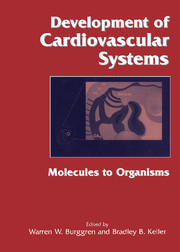Book contents
- Frontmatter
- Contents
- List of contributors
- Foreword by Constance Weinstein
- Introduction: Why study cardiovascular development?
- Part I Molecular, cellular, and integrative mechanisms determining cardiovascular development
- Part II Species diversity in cardiovascular development
- 9 Evolution of cardiovascular systems: Insights into ontogeny
- 10 Morphogenesis of vertebrate hearts
- 11 Invertebrate cardiovascular development
- 12 Piscine cardiovascular development
- 13 Amphibian cardiovascular development
- 14 Reptilian cardiovascular development
- 15 Avian cardiovascular development
- 16 Mammalian cardiovascular development: Physiology and functional reserve of the fetal heart
- Part III Environment and disease in cardiovascular development
- Epilogue: Future directions in developmental cardiovascular sciences
- References
- Systematic index
- Subject index
13 - Amphibian cardiovascular development
from Part II - Species diversity in cardiovascular development
Published online by Cambridge University Press: 10 May 2010
- Frontmatter
- Contents
- List of contributors
- Foreword by Constance Weinstein
- Introduction: Why study cardiovascular development?
- Part I Molecular, cellular, and integrative mechanisms determining cardiovascular development
- Part II Species diversity in cardiovascular development
- 9 Evolution of cardiovascular systems: Insights into ontogeny
- 10 Morphogenesis of vertebrate hearts
- 11 Invertebrate cardiovascular development
- 12 Piscine cardiovascular development
- 13 Amphibian cardiovascular development
- 14 Reptilian cardiovascular development
- 15 Avian cardiovascular development
- 16 Mammalian cardiovascular development: Physiology and functional reserve of the fetal heart
- Part III Environment and disease in cardiovascular development
- Epilogue: Future directions in developmental cardiovascular sciences
- References
- Systematic index
- Subject index
Summary
Introduction
As research in developmental biology over the decades has moved from classic embryology to studies of the cellular and molecular basis of organogenesis, amphibians have emerged as one of several general models for vertebrate development, joining the chick, the mouse, and more recently, the zebra fish. One of the major reasons why frogs, fishes, or any other group of lower vertebrates can be used as a general model for higher-vertebrate development is that early in development the basic patterns, structures, and physiological processes appear to be largely identical (Figure 13.1).The historically important role of amphibians in the study of cardiovascular development can be attributed to their typically large, semitransparent eggs, their relative ease in rearing, and the ability to grow amphibian cells in culture (Slack, 1991). Biologists studying cardiovascular development have recently added amphibian models to their repertoire of vertebrate cardiovascular systems (e.g., Yost, 1994; Danos & Yost, 1995).
Frequently, however, cardiovascular development in amphibians is studied primarily to model these processes in mammals rather than to understand development in amphibians as a subject of interest in its own right. Consequently, the goals of this chapter are not only to describe the general process of cardiovascular development in amphibians from a “vertebrate model perspective” but also to highlight and celebrate the diversity and the unique events to be found in developing amphibians.
Cardiovascular anatomy of amphibians
The cardiovascular anatomy of mature amphibians is among the most complex of all vertebrates. As is the case for most reptiles (see Chapter 14), the presence of an incompletely divided ventricle provides possibilities for controlled redistribution (“shunt”) of oxygenated and deoxygenated blood into the systemic or the gas exchange circuits.
- Type
- Chapter
- Information
- Development of Cardiovascular SystemsMolecules to Organisms, pp. 166 - 182Publisher: Cambridge University PressPrint publication year: 1998



